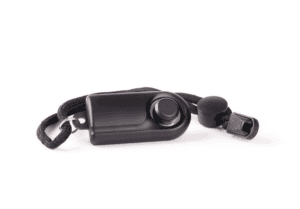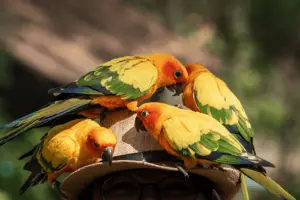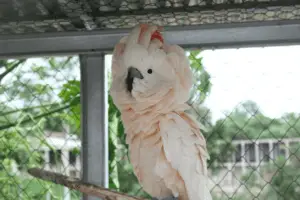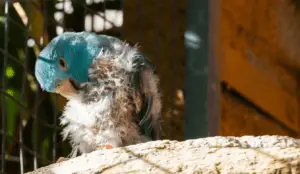Parrots are inquisitive creatures. They are intelligent, and they enjoy music and chewing things like their perches. However, if you choose the wrong wood, it might be the end for your feathered friend. Let’s make sure that doesn’t happen and review the top safe woods for your parrot’s perch. After all, we love our feathered friends, right?
Parrot perches should be an appropriate width so your parrot’s feet can comfortably grasp their perch. Furthermore, if using wood perches, such as poplar, maple, and birch you can ensure your parrot is not negatively affected by the wood.
We’ll swoop into the world of perches, and determine the best types of wood to use. Furthermore, we’ll identify which woods you’ll want to stay clear of. Let’s get started.
Understanding Parrot Perch Needs
Do Parrots Eat Wood?
Parrots don’t generally eat wood. However, a parrot in a cage gets bored quickly and may be inclined to chew away at their perch in a vain attempt to maintain their sanity. Or, they could just try to clean and sharpen their beaks, after all, what parrot leaves food on their beak? So, they rub their beak on the nearest, you guessed it, perch, branch or similar item within range.
That’s not all your parrot’s perch is good for though, not at all. Perches are perfectly good places to sit (or stand) around and relax. A good perch is one that doesn’t make the parrots feet have to splay out flat (too large a perch), nor curl so far around that their toes touch on the other side (too small a perch).
I mentioned that parrots don’t eat wood. However, if you’re into the bigger parrots then you must know they do chew wood – a lot. Here’s why: Parrot beaks are always growing. That’s because they, like your fingernails, get worn down over time, so to compensate, their beaks grow slowly but constantly.
If a parrot isn’t eating things that wear down their beak, then they have to chew on things like wood to keep up with the beak growth, otherwise it can become overgrown.
What Makes A Good Perch?
If you consider a parrot’s feet, they aren’t that dissimilar from our hands. Think of it this way when you’re thinking about a parrot perch: consider a baseball bat. Now, imagine if you had to swing it, but it was as wide as a pencil. Sure, your hands can easily grasp it, but it wouldn’t be too comfortable if you had to hold on tight, because it’s so small. Now try holding that pencil and putting weight into it, the narrow pencil would quickly become uncomfortable, right?
Now, consider that the baseball bat was the width of a basketball. You would need two hands to try to hold and swing it (unless you are a mountain gorilla). Again, it would be too wide and uncomfortable. But what if you made the baseball bat a comfortable couple or three inches in diameter? Now it would be a lot better fit for your hands, and more comfortable to hold. Well, a parrot’s foot is like your hand, and the perch is like a baseball bat – it needs to be the right size or it’s not comfortable for the bird.
Next, consider the material. If a bat was slippery plastic, it might not be so good. That’s why there’s a grip on a baseball bat – so your hand sticks in place. Well, you don’t need a soft grip for a perch, but it helps the parrot a lot if there’s enough of a rough texture that they can easily grip it. That’s why you’ll find a lot of commercial perches for sale have a slightly rough surface. They should be rough enough to grip, but not so rough that it would be uncomfortable. Remember, in the wild, perches are covered in bark.
The Safe Woods For Parrots
Before you rush to the list of safe woods, please consider the following:
Woods must NOT have contaminants: stains, preservatives, pesticides, paints, or chemical treatments
Okay, so now you know to look for ‘raw’ untreated woods with no paint or stain. Now, let’s take a look at which species of wood is safe for your parrot friends.
- Manzanita
- Dragonwood
- Birch
- Balsa
- Ash
- Elm
- Maple
- Java
- Ribbonwood
Toxic Woods: What to Avoid
I love to eat peaches and cherries. However, there’s a reason I don’t eat the pits, aside from them being seemingly impenetrable. As you likely know, fruit pits are often poisonous. In fact, those of the cherry and peach are known for containing a nasty version of cyanide, that is cyanogenic glycosides. Ingest these and you or your bird might not live to tell the tale.
Further to the cyanide concept, I can’t stress enough how you should avoid treated woods. There are multiple studies on the use of hydrogen cyanide for treating wood. So, if there’s any treatment, stay clear. However, as a general rule, stay away from these woods also:
- Cherry
- Apricot
- Peach
- Prune
- Plum
- Nectarine
Tips for Choosing and Preparing Safe Wood
There are two scenarios for perches: 1. You buy them at a store or 2. You collect branches of suitable species. Let’s do a run-through of each.
Commercial Perches
Wood Perches – Go natural, or go home, that’s what I say. The problem with a lot of perches for sale is that they only state that they are ‘natural wood’ (as opposed to unnatural wood?). If a manufacturer doesn’t know what species of wood they used, I recommend staying clear of them.
PVC Plastic – A common material for commercial perches is polyvinyl chloride, better known as PVC. Now, personally, I don’t give my parrots plastic. After all, if it’s not good for a giant patch floating in the oceans, it probably isn’t great for parrots either. Just my opinion, but I try to steer clear of plastic for my birds.
Stainless steel – If I buy a commercial perch, it’s going to be stainless steel. Stainless steel perches will cost more, but they are good for life. These perches won’t rust, they won’t break, and your parrots can attempt to chew them all day and night, they will outlast. The only real downside to stainless steel perches is that they are very bad in two scenarios. Let me explain.
In Cold Conditions – In a drafty area or if your house is on the cool side, then stainless steel perches can give your parrot’s feet a chill. So, as long as your house is a good temperature, steel perches are fine.
The other condition that makes stainless steel perches bad is if they are in the sun. Direct sunlight will heat up stainless steel to the point where your birds will burn their feet. So, keep them out of the sun, and out of the cold, but otherwise they will last a lifetime (or several lifetimes).
Found Perches
I’m a big fan of finding my own perches. Take a few minutes to look at the big commercial sites and you’ll soon tire of trying to figure out what ‘natural wood’ is. I must have spent an hour just trying to find one for sale that actually stated what species of wood they used.
My favorite two types of perches are birch and maple. Maple is easily identifiable by the leaf – there’s no leaf exactly like it, and if you can’t remember what it looks like, just look at the Canada flag – it sports a maple leaf right in the middle (although it’s red).
I also like maple because it’s a hardwood. I mean, balsa is great too, but it’s so light and easy to manipulate that parrots tend to destroy it in no short order. However, with a hardwood like maple, they have to work at it for a long time, meaning that your perches will last longer.
Birch is my second favorite. It’s not as common where I am, compared to maple, but it’s easy to identify by the white bark that peels off like paper. Moreover, birch is another hardwood like maple. That means that it has a relatively good hardiness against parrot chomping.
Safety Considerations
I know I’ve sold you on natural wood (of the specific species mentioned) but there is one downside you must be aware of when bringing wild wood into your home. Pests that have burrowed into the bark can become a serious problem in your home. So, always strip the bark off outside and bring the raw fresh wood in for perches. That way you can see if anything has burrowed into the wood, and if it has, dispose of the wood accordingly.
Summary
In this comprehensive guide, I’ve explored the essential role of perches in a parrot’s life, emphasizing the need for careful selection of wood types. We talked about the various safe woods for your parrot’s perch, including manzanita, dragonwood, birch, balsa, ash, elm, maple, java, and ribbonwood.
Conversely, we discussed the woods to avoid, like cherry and apricot, due to their toxicity.
Commercially available perches and self-sourced perches were examined, with a preference for ‘raw’ untreated woods and caution against plastic.
Furthermore, I provided advice on choosing and preparing wood for perches while considering safety aspects such as potential pest infestation. Armed with this information, you can now make a well-informed decision about the best wood for your parrot’s perch.
- Thorsten Pickel, Britta Scholz, Lars Schrader, Perch Material and diameter affects particular perching behaviours in laying hens. Elsevier, Applied Animal Behaviour Science. Science Direct. Retrieved May 24, 2023.
- Ondřej Douda, Miloslav Zouhar, Marie Maňasová, Milan Dlouhý, Jana Lišková & Pavel Ryšánek, Hydrogen cyanide for treating wood against pine wood nematode (Bursaphelenchus xylophilus): results of a model study, Journal of Wood Science, 61, 204-210 (2015). Retrieved May 24, 2023.
- Maple, Wikipedia, Wikipedia contributors, https://en.wikipedia.org/wiki/Maple










